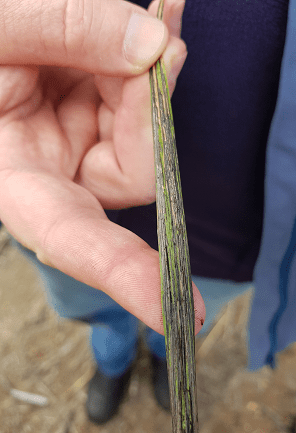WHEAT growers across the Western Australian grainbelt have been warned to take precautions to protect next year’s crops from the risk of the fungal disease, flag smut.
The WA Department of Primary Industries and Regional Development has received several reports of wheat flag smut from Yuna in the north, through the central and eastern regions down to Esperance in the south.

Cereal growers have been urged to watch for the dark streaks of flag smut on the leaves of their wheat and to take action to prevent the fungal disease from spreading and infecting their 2021 crop.
The presence of the fungus in conjunction with the warm, dry start to the 2020 growing season favoured plant infection shortly after germination this year, in instances where fungicide seed dressings were not applied.
Flag smut (Urocystis tritici) is both a seed and soil borne disease, which at high incidence can cost growers dearly in lost yields and downgraded seed quality.
Research scientist Ciara Beard encouraged growers to monitor crops as they harvest for signs of flag smut and to adopt preventative measures to reduce the risk of the disease spreading and occurring in next year’s crops.
Ms Beard said as flag smut only occurred intermittently, cereal growers may not be familiar with the symptoms, which are exhibited on plant leaves rather than heads.
“It is best to look on plant leaves for long raised streaks of sooty black spores, which rub off easily,” she said.
“Affected plants are often stunted, with curled leaves, which can tiller excessively and do not usually produce grain.
“During harvest flag smut spores are spread, contaminating healthy seed, soil and machinery – we have already received a report from one grower who has seen black spores on their header as they are harvesting.”
Growers with paddocks infected with flag smut are encouraged to wash down machinery thoroughly to avoid contamination and spreading the disease.
Fungus spores can be carried on the seed and in the soil and can survive for up to seven years in the latter.
Ms Beard said that both seed and soil borne flag smut could easily and effectively be controlled using a registered fungicide seed dressing.
“In paddocks contaminated with flag smut and adjacent paddocks, use clean seed treated with a registered fungicide seed dressing at a registered rate to reduce the disease risk,” she said.
“There’s no use scrimping on the rate, as seed that misses treatment or isn’t treated at the registered rate will continue the spread of the disease.
“Seed dressings also offer valuable protection from a range of other foliar and seed-borne diseases.”
There are a growing number of wheat varieties that have resistance to flag smut, which are documented in the WA Crop Sowing Guide.
“The disease has been reported this year in varieties that have susceptible to very susceptible, and very susceptible ratings,” Ms Beard said.
“Growers with paddocks infected with flag smut can consult the Sowing Guide online to identify a less susceptible variety to sow next year.”
Source: DPIRD
Further details of the current flag smut situation can be found in the department’s PestFax newsletter available online at agric.wa.gov.au.
The website also has more information about flag smut biology, identification, management and treatment options, and registered fungicide seed dressings, while the 2020 Crop Sowing Guide can be downloaded for free, with the release of the 2021 edition imminent.

HAVE YOUR SAY